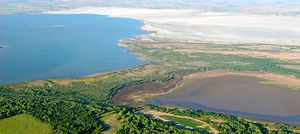Salt Plains (Oklahoma): Difference between revisions
| Line 47: | Line 47: | ||
==References== | ==References== | ||
[ | -[1] | John W. Morris, Charles R. Goins, and Edwin C. McReynolds, Historical Atlas of Oklahoma (Norman: University of Oklahoma Press, 1986). | ||
-[2] | | |||
-[3] | | |||
-[4] | | |||
-[5] | | |||
-[6] | | |||
Edited by | Edited by Brian Chan, a student of Angela Kent at the University of Illinois at Urbana-Champaign. | ||
<!-- Do not edit or remove this line -->[[Category:Pages edited by students of Angela Kent at the University of Illinois at Urbana-Champaign]] | <!-- Do not edit or remove this line -->[[Category:Pages edited by students of Angela Kent at the University of Illinois at Urbana-Champaign]] | ||
Revision as of 21:03, 8 April 2013
Introduction
In the introduction, briefly describe the habitat that is the topic of this page. Introduce the habitat, its ecological significance, and the importance of microorganisms in this environment. (What processes do they carry out? What functions do they perform?)
The Great Salt Plains is an 840-acre Oklahoma state park located in Alfalfa County, Oklahoma. This area is a natural hyper-saline environment. Permian brine comes up from deep in the plains to the surface where it evaporates. Scientists believe that salt was deposited during repeated water-level rises of a shallow sea millions of years ago. The supply of salt is kept intact by saline groundwater that flows just a few feet below the surface. When the water evaporates, a layer of salt remains on the surface. This process also plays a role in the formation of selenite crystals that visitors covet [1]. When the rains arrive, they dissolve the top layer of salt creating small waterways and pools of water. These small areas of water change the concentration of salt very quickly from low to high concentrations. With a huge expanse of no vegetation, there is no shade/protection from the sun's ultra violet rays. Over a typical 24-hour day the average temperature range around 30°C. The combination of the salinity, temperature, and UV makes this an extreme environment.
Physical environment
Describe the physical and chemical characteristics of the environment, using as many sections/subsections as you require. If it is appropriate, you can divide the physical and chemical attributes of the environment into separate sections. Look at other topics available in MicrobeWiki. Which involve processes similar to yours? Create links where relevant.
Subsection 1
Subsection 1a
Subsection 1b
Subsection 2
Microbial communities
What kind of microbes do we typically find in this environment? Or associated with important processes in this environment? Describe key groups of microbes that we find in this environment, and any special adaptations they may have evolved to survive in this environment. List examples of specific microbes that represent key groups or are associated with important processes found in this environment. Link to other MicrobeWiki pages where possible.
Are there important biological interactions that are important in this environment? Do these interactions influence microbial populations and their activities? How do these interactions influence other organisms? Describe biological interactions that might take place in this environment, using as many sections/subsections as you require. Look at other topics available in MicrobeWiki. Create links where relevant.
Subsection 1
Subsection 1a
Subsection 1b
Subsection 2
Microbial processes
What microbial processes define this environment? Describe microbial processes that are important in this habitat, adding sections/subsections as needed. Look at other topics in MicrobeWiki. Are some of these processes already described? Create links where relevant.
Subsection 1
Subsection 1a
Subsection 1b
Subsection 2
Current Research
Enter summaries of recent research here--at least three required
References
-[1] | John W. Morris, Charles R. Goins, and Edwin C. McReynolds, Historical Atlas of Oklahoma (Norman: University of Oklahoma Press, 1986). -[2] | -[3] | -[4] | -[5] | -[6] |
Edited by Brian Chan, a student of Angela Kent at the University of Illinois at Urbana-Champaign.

